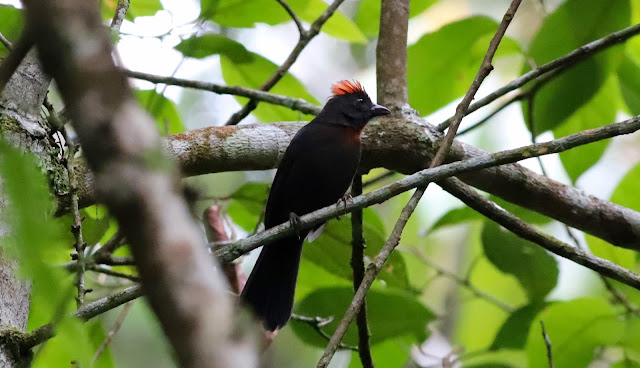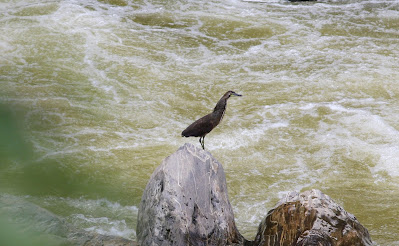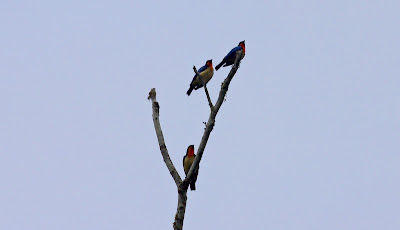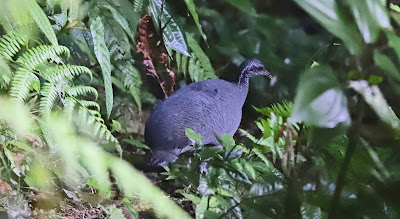September 2021: A Continuation of a Target Birding Trip in Colombia
Phase 2 of the trip started out with a traffic jam. Our route to Tolima was a bit of a slog and we ended up sitting in traffic for hours while landslides were cleared and roads were opened up again. It's one of the inevitabilities of traveling in the Andes. The roads snake through river valleys and regularly get blocked by falling trees or mud-slides or get washed out by floods. Everyone here is patient, there really isn't much of a choice and certainly no sensible alternative routes, and so there really isn't much to do but look at the birds and relax. Eventually we made it to where we needed to get to, a little later than planned, but both in one piece.
Thursday, September 2 - Cañon del Rio Combeima / Ukuku Rural Lodge.
If you want to see doves you need to drive the roads early in the morning or be prepared for a long hard slog later in the day. This maxim has been a fixture on so many trips I've been on, that it hardly seems odd to get up early and fret about being the first car to dive up a road before others have flushed the doves back to the forest. The doves for their part often seem to oblige, toddling along on the roadside in the early low light and allowing for unobstructed views before slinking off into the undergrowth to hide for the rest of the day. So at dawn on Tuesday we were driving up the Combeima River Canyon, hoping to beat any other traffic, with doves on our mind.
In the end we saw quite a few Tolima Doves, or at least birds we assumed were Tolima Doves. We needed to get a good look though, see eye color, for a confirm on what was a life bird for me. So we pushed up the valley, stopped when we saw a dove ahead of us, and tried to get scope views. In the end we were also able to play a little tape and had one come crashing in close to us, giving us the necessary reassurance views. One endemic down, two to go ...
 |
| Yellow-headed Brushfinch |
I'd seen Santa Marta Blossomcrown with Daniel a few years before so I was curious to complete the set as it were and see the Tolima Blossomcrown too. Now all that we had to do was find one among the 15 species of hummingbird that buzzed around the lodge's feeders and ornamental plantings. There really were a lot of birds, Sparkling and Lesser Violetears, Bronzy and Collared Incas, Buff-tailed Coronets, Booted Racket-tails, Fawn-breasted Brilliants and White-bellied Woodstars, the list went on and on. The blossomcrown made it's appearance of course just after someone from the lodge had handed me a cup of coffee, making me spin around looking for a level place to put it down then rush over just in case this was it's only visit of the morning. In the end we needn't have worried though as 2 or 3 birds snuck into the plantings fairly regularly (but never to the feeders) and fed low down in the flowering shrubs many times over the next few hours. A truly lovely spot.
 |
| Red-billed Emerald and Tolima Blossomcrown |
 |
| Yellow-chinned Spinetail and Night-Money sp. |
The highlight of the whole Colombia trip for me was a chance to go to this reserve. We started early and had to drive a long and winding road through farm fields in order to get there, but we made plenty of stops and got some good birds.
First decent bird of the day was a lifer for me, a Large-billed Seed-Finch which we found just outside a small village in roadside grasses. As we made our way towards the park, the birds kept coming and by the time we got to the forest proper we had seen 60 or so species before we'd even reached the reserve.
The reserve HQ entrance though presented another challenge. Two rangers had ridden out on dirt bikes to meet us at the nearest village and escort us in. The road was narrow but passable but as we peeled off the main road to get down to the lodge the track narrowed until we eventually reached a place where the track had recently washed out all together. To patch it up the rangers had assembled a sort of dam of sandbags and filled in an improvised roadway behind them. Between the somewhat soft and unstable wall of sandbags, and the sheer sand cliff on the other side of the new 'road', was a muddy runway perhaps 7 feet wide. We were traveling in Daniel's brand new, very shiny, very expensive Toyota LandCruiser, which coincidentally was roughly 7 feet wide. To drive across the 'road' Daniel had to put one wheel on the sandbags, which visibly sagged and separated under the weight of the car, and have one wheel pressed up against the cliff. Six inches the wrong way and he'd be scratching up one side of the car or sending it tumbling into a morass of mud and jungle vegetation in the stream bed below. I got out of the car and walked (!), Daniel, looking cool and calm but with decidedly white knuckles, edged the car delicately between destruction and disaster and somehow managed to bring it through. Nerves of steel ...
 |
| Somewhat traumatized Boa Constrictor and the Colombian Chachalaca intent on murdering it |
After dinner we decided to do a little owling and set out in search of Choco Screech-Owl. We weren't technically in the Choco but on many range maps there's a little 'hook' where Choco specialists spread up into the Magdalena Valley. The screech-owl was one of those and also, luckily for us, a curious creature who came in close to check us out in the darkness.
 |
| Choco Screech-Owl |
Next day we had a few target birds I wanted to see so we focussed on them. Black Antshrike was easy to hear but took us a very long time to see and we ended up devoting a fair amount of the morning to it. Russet-winged Schiffornis was my other target and, after hiking up a trail to a known territory we were able to get one to call but again had to work hard to see it sitting still in the dark understory of the forest. Through the morning though we kept adding species and in the evening went back to the tower, racking up a really nice list of birds for the day.
 |
| Bare-crowned Antbird and Purple-throated Fruitcrow |
 |
 |
| Black-chested Jay and Orange-winged Parrot |
Monday/Tuesday, September 6/7 - RN Cañon del Río Claro
All too soon it was time to leave one wonderful place, only to swap it for another. Maybe COVID ironically helped us here because at peak season, in normal times, I bet the Rio Claro Canyon is a zoo filled with crowds of tourists walking the trails, swimming and tubing on on the clear waters of the river. As it was, the resort was reasonably quiet while we were there. There were a few tourists but the trails weren't crowded and we were able to bird comfortably without dodging crowds of shrieking kids.
Out main activity for out first evening there was to look for the endemic Antioquia Bristle-Tyrant, a tiny yellow flycatcher that likes the canopy of tall trees and is generally rare and difficult to see even where it does occur. Then, having failed in our first attempt there, we went to a cave a mile or so up river and waited for the Oilbird spectacular, eventually seeing hundreds of them emerge and whirl over the river as the light faded away (it sounds touristy but it was very cool).
Next day we tried again twice for the bistle-tyrant (nope) and birded some local trails, cobbling together a nice mix of locals and adding some things to the trip list. Then, just as I'd given up on the little bugger, attempt number 4, just as we were leaving, and the bristle-tyrant surrendered. Sweet victory!
 |
| Antioquia Bristle-Tyrant in all it's glory ... |
After two plus weeks you really get into the routine of a birding trip but all good things come to an end even if it felt like a surprise to realize that the last day had arrived and I was less than 24 hours from my return flight from Medellin to New York. With few targets left, Daniel suggested we try maybe for the Red-bellied Grackles that seemed regular at a relatives garden/nursery. So we went along and spent a morning in a beautiful garden seeing lots of birds but no grackles. As so often is the case though, the change of scenery made the difference and we went off, up the road to some higher elevations, before returning to the garden. Just before we got there, two things happened quickly ... two Tyras, oversized weasel relatives, crossed the road in front of us and then ... we found the grackles and got to spend some quality time with them.
 |
| Red-bellied Grackle |
And so the trip ended. Roughly 400 species, roughly 40 of them lifers for me. Wonderful country, wonderful company and zero COVID-related hassles. Pretty much the perfect trip. Can't wait to get back to Colombia one day.
 |
| Andean Motmot |


































